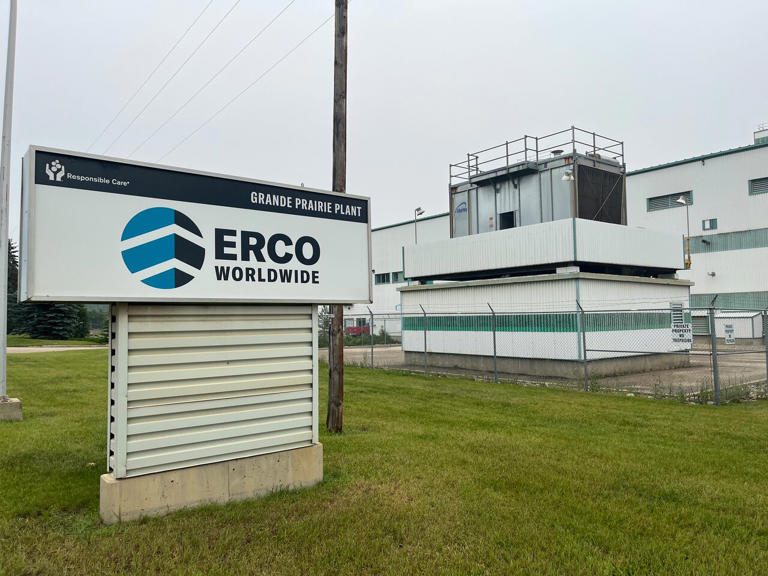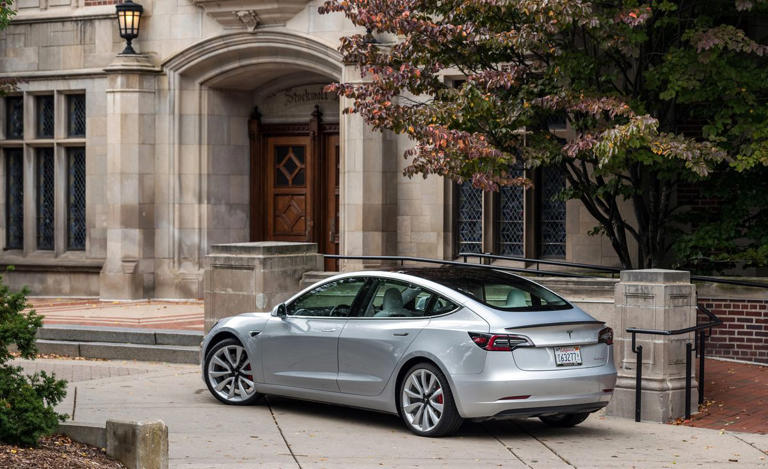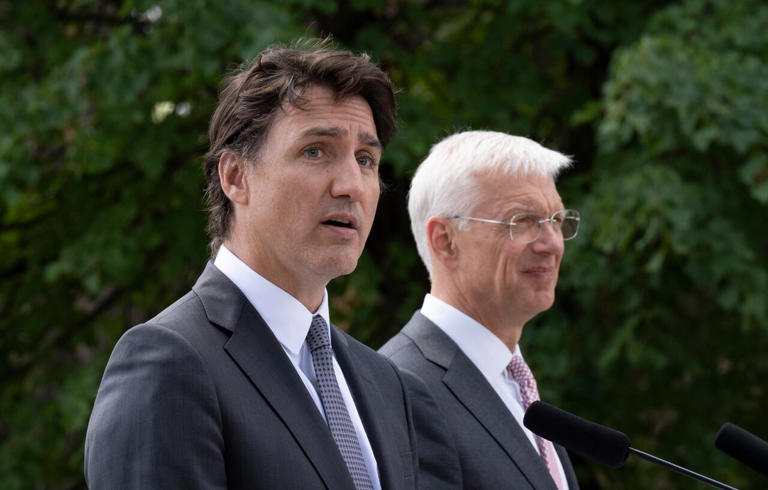LNG’s future unclear as conference kicks off in Vancouver
Story by The Canadian Press • Yesterday
The world’s largest liquefied natural gas (LNG) conference kicked off on Monday in Vancouver, and with it comes uncertainty over the long-term viability of gas export projects in development in Canada.
The conference, which runs until Thursday, takes place as multiple LNG projects are in the early stages of development on the West Coast, including the First Nations-led Cedar LNG in Kitimat, B.C., that will export gas to Asian markets. The Haisla Nation is invested in the project.
The next two to three years will be critical in deciding the fate of Cedar LNG, Robert Johnston, executive director at the Center on Global Energy Policy at Columbia University, said in an interview with Canada’s National Observer.
“That’s when you get financing,” he added.
On Tuesday, it was announced in a press release that Johnston will also be the lead advising researcher for the First Nations Climate Initiative, a B.C.-based forum composed of Lax Kw’alaams, Metlakatla, Nisga’a and Haisla First Nations created to fight against poverty and climate change.
Johnston, alongside other researchers and industry CEOs, will advise the First Nations Climate Initiative’s international advisory committee, which will research and advise on LNG exports to Asia, including a demand-side outlook for the continent, decarbonization and the global competitive market that includes petro-state producers like Russia and Qatar.
Ultimately, it will be the decisions of investors, their gamble on whether there is long-term viability for gas exports to Asia and that continent’s energy transition, Johnston added.
LNG Canada, another LNG export facility in Kitimat, is currently 85 per cent completed. The project is a joint venture between Shell PLC, Petronas Nasional Berhad, PetroChina Co. Ltd., Mitsubishi Corp. and the Korea Gas Corp.
It’s unclear if similar large Asian gas corporations will invest in Cedar LNG, too, but Johnston said gas import infrastructure already exists in gas- and coal-dependent countries like Japan, Taiwan, Korea and China. It also remains to be seen whether other coal-dependent countries in Asia like India, Indonesia and Vietnam will invest in LNG infrastructure or instead hopscotch to clean energy like renewables. Currently, the most important consideration for those countries is price, and coal’s cost has remained low due to the war in Ukraine, Johnston said.
Many countries in Asia have built coal plants within the past decade or two, raising questions over the next steps in an energy transition that is demanding a steep drop in greenhouse gas emissions in the near future.
Meanwhile, some Asian countries face challenges in cleaning up their energy mix due to limited space for large wind and solar farms, Johnston said.
Nuclear development is also expanding in places like China, but it remains controversial in Korea and Japan after the Fukushima disaster, Johnston explained.
In Japan, for example, dependency on natural gas spiked following the nuclear disaster in 2011, which idled many of its nuclear plants, Reuters reports.
However, as Asian countries aim for net-zero emissions by 2050 — or 2060, for China — it’s not a given that natural gas will remain viable in those markets. Other energy sources could replace gas as nations work to fulfil their climate obligations. That’s why Johnston says long-term projections are uncertain, with different scenarios showing different outcomes.
But as of right now, there are still long-term gas contracts being signed, Johnston said.
“Will those be white elephants up to 20, 30, 40 years from now?” Johnston asks. “Possibly, but these contracts are designed to share that risk between buyer and seller.”
Fossil fuels like natural gas and coal are both significant propellants of climate change, which has seen global temperatures reach record highs over the past week.
On Tuesday, climate activists from Frack Free BC staged a die-in outside the LNG conference over the oil and gas industry’s role in worsening climate disasters like extreme heat waves, droughts and other weather phenomena taking place more often and more severely than in previous decades.
Frack Free BC also points to the fracking needed to extract much of Canadian LNG for export, arguing the method for extracting oil and gas is as bad for the climate as coal. The group also notes methane, the primary component in natural gas, is 84 to 86 times more powerful than carbon dioxide over a 20-year period.
Countries like the United Kingdom, France and Australia have already banned fracking over earth tremors and environmental concerns, like the heavy energy output needed to extract products.
“Oil and gas companies have spent billions of dollars lobbying politicians and peddling lies about clean gas,” Alexandra Woodsworth, director of organizing at Dogwood, a B.C. environmental non-profit, said in a press release.
“The research is crystal clear: there’s no room for new LNG if the world [wants to meet] its climate commitments. Any politician who claims otherwise is just helping the industry greenwash its image.”
Matteo Cimellaro, Local Journalism Initiative Reporter, Canada's National Observer
Uncertain demand clouds future of Canada's planned LNG exports, experts say
Story by The Canadian Press • Yesterday

VANCOUVER — Canadian liquefied natural gas projects looking to fill gaps in the global market left by the absence of Russian gas may run into more challenging conditions than expected, industry experts have told a global conference in Vancouver.
They said the consensus among economists is that the gas shortage in Europe caused by the war in Ukraine is unlikely to last beyond 10 years, while the rise of renewables will cut into demand from 2030 onward.
Peter Abdo, chief commercial officer for LNG for German energy giant Uniper, told the LNG 2023 conference his company is committed to entering into 10-year contracts with potential suppliers — but longer-term deals will be more challenging because of Europe's uncertain long-term demand for natural gas.
"I guess the caveat is, if any European player is entering into a long-term contract irrespective of the portfolio benefits, let's just make sure that we have enough flexibility in that deal to where we can take it to Asia or some other market, in case we're faced with a situation like stranded gas," Abdo said.
Octavio Simoes, president and CEO of U.S.-based natural gas firm Tellurian, agreed that the biggest opportunity opened by the European gas shortage is in Asia, a region with a much brighter long-term outlook in LNG demand.
However, Simoes said challenges remain on that front.
He told the conference that the current European gas shortage revealed a fundamental challenge for anyone wanting to sell LNG to Asia, as planned by projects in British Columbia — price may be the ultimate determining factor, not environmental standards touted by the West.
Simoes said European countries such as Germany jumped into the LNG market in the last two years to replace Russian gas, paying more for the commodity and essentially "taking it from the rest of the world" while driving up prices.
He said high prices pushed Pakistan to abandon plans to buy natural gas and instead quadruple commitments to coal, and similar trends are happening in Indonesia, Thailand, Vietnam and the Philippines.
"I look at it from the principle that we have roughly half the (global) population — 4 billion people — living on less than $7 a day," Simoes said. "So whatever we do to decarbonize, if it's not affordable, it's not going to happen."
Earlier in the conference, LNG Canada CEO Jason Klein had said Canada would be competitive on the global market, partially due to its high environmental and social standards.
Klein said the $40-billion LNG Canada export facility in Kitimat, B.C. — the only one of its kind to reach the construction stage on the Canadian West Coast — is about 85 per cent complete and is scheduled to begin exports by "mid-decade."
In a written statement, the $40-billion joint-venture LNG project's management said it does not comment on pricing and market conditions, but reiterated the facility will produce an affordable supply through "highly efficient equipment" and "access to an abundant supply of low-cost" Canadian natural gas.
The CEO of multinational energy giant Petronas, which is backing LNG Canada, said Tuesday that he agrees pricing will play a big role as Asian countries decide whether to import LNG, switch to renewables or stay with coal.
But Muhammad Taufik told the conference that each market has unique dynamics, and Canadian LNG's emphasis on environmental and social standards has a market in many Asian countries.
That demand will grow, he said, as governments around the world develop more concrete carbon-pricing policies, which would add more incentive for countries to buy lower-polluting fuels like LNG.
"They will want this high-quality LNG," he told the conference. "I can tell you already that my marketing and trading team are already delivering — or have already delivered — carbon-neutral LNG, and there have been customers who are specifically asking for carbon-abated cargoes."
One such market would be China, said PetroChina International's senior vice-president Keith Martin.
Martin said Chinese President Xi Jinping's announcement at the United Nations two years ago that China would achieve carbon neutrality before 2060 has set the world's second-largest economy strictly down the path of buying lower-emitting fuels such as LNG.
"When President Xi made that speech at the UN, that wasn't just a speech," Martin said. "That was an order."
Muhammad Taufik said that comparing LNG's costs and benefits as a whole, versus coal and renewables, may play to its advantage in Asia.
The key for LNG Canada and other Canadian projects, he said, is timing, making it imperative that production does not get delayed, thereby missing the window.
"A call-out to our Canadian friends: You do have probably one of the most unique opportunities to be part of the global solution," he said. "You are just naturally positioned to cater to these markets, and I think it would be a huge opportunity lost if we do not pivot to actually respond to those needs."
This report by The Canadian Press was first published July 11, 2023.
New emissions targets may sink LNG’s pitch as a shipping fuel
Story by The Canadian Press • Yesterday
The fossil fuel and shipping industries just got a serious shot across the bow over relying on liquefied natural gas (LNG) as a transition fuel.
On Friday, the International Maritime Organization (IMO) finalized stricter global emissions standards for the maritime industry while closing a significant regulatory loophole driving up the use of LNG as a shipping fuel.
LNG has lower CO2 emissions than other fossil fuels used in shipping but it also emits significant amounts of methane, a short-lived but powerful greenhouse gas responsible for more than 25 per cent of current global warming.
Past emissions rules focused solely on reducing shipping’s CO2 emissions and failed to fully include methane, which makes up 70 to 90 per cent of natural gas.
The IMO’s new emissions strategy now considers the full life cycle of shipping fuels — also known as well-to-wake greenhouse gas (GHG) emissions.
The new accounting method means LNG can no longer sail under the radar when it comes to emissions, said Elissama Menezes, global campaign director for the Say No to LNG coalition.
“It’s a huge step and quite exciting to see,” Menezes told Canada’s National Observer.
“At the end of the day, it really brings some accountability to the shipping sector, which for too many years has not really been responsible for the whole footprint of its emissions.”
The oil and gas industry has aggressively pitched LNG as a bridge fuel until low- or zero-emission alternatives are fully developed in the shipping sector.
Compared to dirty heavy fuel oil (HFO) predominantly used in shipping, LNG does emit less carbon dioxide and harmful air pollutants like sulphur, while meeting previous emission standards and being economically attractive to the shipping industry.
Consequently, methane emissions from shipping surged by as much as 155 per cent from 2012 to 2018, according to the IMO.
“Methane emissions have been growing at a much faster pace than any other greenhouse gas and it’s becoming more of a problem over time,” said Bryan Comer, marine program lead for the International Council on Clean Transportation.
Half of all newly built cruise ships and a large share of recently built container ships are designed to be fuelled with LNG, he said.
Related video: The US pushes for 'green shipping corridor' (WION)
Duration 1:19 View on Watch
Fugitive emissions, or methane slip, along the length of the value chain — including extraction, processing, storage, distribution and even gas released unburned from engines — is the “Achilles heel” of LNG, he added.
The amount of methane that slips on vessels varies according to the type of engine used. High methane slip engines consumed 40 per cent of LNG marine fuel in 2017, with one of the most common and worst offenders being low-pressure, dual-fuel engines.
The well-to-wake emissions accounting, combined with the IMO’s plan for mid-term measures such as more stringent greenhouse gas fuel emissions standards slated for 2027, will likely increase the uptake of alternative low- or zero-emission fuels and drive down demand for LNG, Comer said.
He noted the European Union is also set to regulate methane as soon as 2025 under new fuel standards aimed at decarbonizing the maritime sector.
The new regulatory measures will require industry investment to improve fuels and engine technology. And all forms of LNG will likely become increasingly impractical as a marine fuel due to the associated costs and uncertainty associated with scaling up bio and e-LNG (“renewable” LNG), which is estimated to be seven times more expensive than fossil LNG by 2030, Comer said.
Other alternatives involving wind, green methanol, hydrogen and ammonia could offer low life cycle emissions without the same methane slip problems, he added.
“It’s not that LNG won’t be allowed, it’s just that the market won’t be as strong as current projections suggest,” Comer said.
“When some of these infrastructure decisions are being made, there are probably better things to spend your money on.”
The IMO has provided Canada’s fossil fuel industry and the maritime sector with a wake-up call to adapt to a future that doesn’t involve natural gas, said Andrew Dumbrille, Canada campaigner with Say No to LNG.
Canada supported ambitious global GHG reduction targets and well-to-wake accounting at the IMO, but continues to buy into domestic LNG fracking projects and building large LNG fuelling depots at home ports, Dumbrille said.
Aside from methane slip issues, the LNG production chain involves other social, health and environmental risks, and its emissions fuel climate impacts like the savage wildfire season underway across the country, he said. It also threatens Canada’s ability to meet its own emissions targets.
Continued investment in LNG infrastructure by Canada and B.C., like the Tilbury LNG Marine Jetty in Delta on the Fraser River, risks stranding infrastructure or vessel assets while reducing financing for other zero-emission solutions, Dumbrille said.
The World Bank has dismissed LNG as a viable option for decarbonizing the shipping industry, finding it has a limited role as a shipping fuel before 2030, and that countries and businesses investing in LNG infrastructure to meet IMO climate targets are risking unnecessary spending and technological lock-in.
The growing fleet of LNG ships risks financial losses of $850 billion by 2030, recent research suggests.
“LNG development and shipping in Canada is fast approaching its best-before date,” Dumbrille said.
Rochelle Baker, Local Journalism Initiative Reporter, Canada's National Observer
Alberta and B.C. in talks to expand Canadian LNG reach globally, Danielle Smith says
Story by The Canadian Press • Yesterday

VANCOUVER — Alberta Premier Danielle Smith said her province has begun talks with British Columbia as part of a push to greatly expand the reach of Canadian natural gas to more foreign markets.
Speaking on the final day of the international LNG 2023 conference in Vancouver, Smith said delegates told her that many countries in Asia cannot meet emission reduction goals without natural gas, and the goal should be for Canada to fill — and benefit from — that gap.
She expressed frustration about the lack of federal infrastructure that would allow Alberta producers to fulfil global market needs.
"With the right infrastructure in place, Western Canada would become a sought after supplier for both Asia and Europe," Smith told conference attendees.
"Shipping LNG from Canada's West Coast to Asia takes 11 days, compared to 20 days from the U.S. Gulf Coast."
"With the completion of proposed projects in Atlantic Canada, shipping Western Canada's gas to Europe would take seven to eight days, and that would be less than any other North American LNG project."
In an attempt to spur more LNG export projects on the West Coast, Smith said she and B.C. Premier David Eby began a discussion two weeks ago to explore leveraging Article 6 of the United Nations Paris Accord, which allows Canada to gain carbon credits for reducing emissions abroad.
Smith said she wants to see Alberta and B.C. "pioneer" a way to use Article 6 to create more interest in export infrastructure that would supply Asia with LNG, while Canadian jurisdictions gain the credits that are generated from displacing more polluting fuels such as coal in those markets.
Related video: Proposed new mine divides former Alberta coal town (cbc.ca)
"I feel like this is an integral part of a global strategy for emissions reduction, and I think that Alberta has an obligation as the owner of the resource in our province to take a lead making sure we build that consensus," Smith said.
The massive LNG Canada project in Kitimat, B.C., a $40-billion-dollar project that is about 85 per cent complete, is the only such export facility under construction in Canada and is scheduled to begin delivery mid-decade.
Speaking earlier this week, Eby confirmed he was speaking with other premiers about the LNG opportunity and the awareness that there is a global demand for Canadian natural gas internationally.
However, Eby said he is "not at all confident" that B.C. is on track to provide the necessary electricity to move the natural gas industry locally away from fossil-fuel usage, something that companies such as Malaysian energy giant Petronas mentioned as a key part of the Canadian LNG brand.
"It takes eight to nine years to fulfil a request from industry for the kind of electricity that they're looking for," Eby said. "It takes about the same time to go through the call for power all the way through to generation and transmission."
"We have to speed that up."
Eby said a task force had been set up to do exactly that, to ensure B.C. does not miss LNG's economic opportunity.
Smith said Alberta is not stopping at talking to B.C., identifying the Yukon-Alaska corridor through Skagway, a Saskatchewan-Manitoba corridor to Churchill and possible links to James Bay in Ontario as ideas to explore.
"I'm looking at all of those options," she said. "I think out best option, since we already see so many LNG projects underway with partnership of Indigenous communities, is making sure we can tie in our gas into those project lines."
This report by The Canadian Press was first published July 13, 2023.
The Canadian Press





















